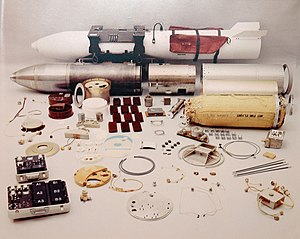B83 nuclear bomb
This article needs additional citations for verification. (April 2010) |
| B83 | |
|---|---|
 | |
| Type | Unguided bomb |
| Service history | |
| In service | 1983- |
| Used by | United States |
| Production history | |
| Designer | Lawrence Livermore National Laboratory |
| No. built | 650 |
| Specifications | |
| Mass | 2,400 pounds (1,100 kg) |
| Length | 12 feet (3.7 m) |
| Diameter | 18 inches (46 cm) |
| Blast yield | 1.2 megatons (maximum) |

The B83 nuclear weapon is a variable-yield gravity bomb developed by the United States in the late 1970s, entering service in 1983. With a maximum yield of 1.2 megatons (75 times the yield of the atomic bomb "Little Boy" dropped on Hiroshima on August 6, 1945, which had a yield of 16 kilotons,) it is the most powerful nuclear free-fall weapon in the United States arsenal.[1] It was designed at Lawrence Livermore National Laboratory, and the first underground test detonation took place on December 15th 1984.
History
The B83 was based partly on the earlier B77 program, which was terminated because of cost overruns. The B83 replaced several earlier weapons, including the B28, B43, and to some extent the ultra-high-yield B53. It was the first U.S. nuclear weapon designed from the start to avoid accidental detonation, with the use of "insensitive" explosive in the trigger lens system. Its layout is similar to that of the smaller B61, with the warhead mounted in the forward part of the weapon to make the bomb nose-heavy. It was intended for high-speed carriage (up to Mach 2.0) and delivery at high or low altitude. For the latter role, it is equipped with a parachute retardation system, with a 46-foot (14-meter) Kevlar ribbon parachute capable of rapid deceleration. It can be employed in free-fall, retarded, contact, and laydown modes, for air-burst or ground-burst detonation. Security features include next-generation permissive action link (PAL) and a command disablement system (CDS), rendering the weapon tactically useless without a nuclear yield.
Design
The bomb is 12 feet (3.67 m) long, with a diameter of 18 inches (457 mm); the actual nuclear explosive package, judging from published drawings, occupies some 3 or 4 feet (90 to 120 cm) in the forward part of the bomb case. The bomb weighs approximately 2,400 pounds (1,100 kg); the location of the lifting lugs shows that the greater part of the total mass is contained in the nuclear explosive. It has a variable yield: the destructive power is adjustable from somewhere in the low kiloton range up to a maximum of 1.2 megatons (1.2 million tons of TNT).
The B83 can be deployed by all current US nuclear certified aircraft such as:
About 650 B83s were built and the weapon remains in service as part of the United States "Enduring Stockpile".
Novel uses
The B83 is one of the weapons considered for use in the "Nuclear Bunker Buster" project, which for a time was known as the Robust Nuclear Earth Penetrator, or RNEP. While most efforts have focused on the smaller B61-11 nuclear bomb, Los Alamos National Laboratory was also analyzing the use of the B83 in this role.
The warhead contained within the B83 has been considered for use against near earth asteroids. Six such warheads, configured for the maximum 1.2 MT yield, would be deployed by maneuvering space vehicles to "knock" an asteroid off course, should it pose a risk to the earth.[2]
In popular culture
- In the 1996 film Broken Arrow, two B83 bombs are stolen.
- In the strategy game World in Conflict, a B83 is considered the last resort if the US Army failed to retake Seattle from the Soviet Union before the arrival of the PLA naval forces.
See also
References
- ^ Blaney, Betsy (26 October 2011). "End of an Era: Last of Big Atomic Bombs dismantled". San Francisco Chronicle.
- ^ "NASA plans 'Armageddon' spacecraft to blast asteroid" article at Flightglobal.com
